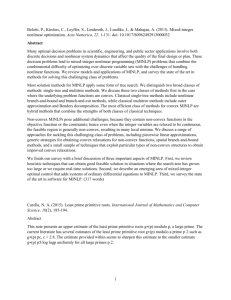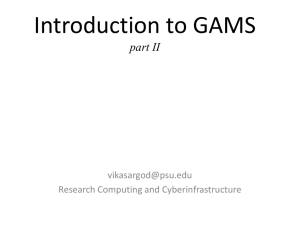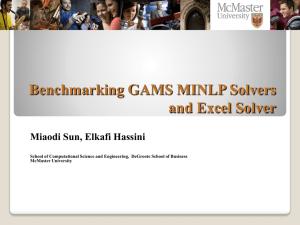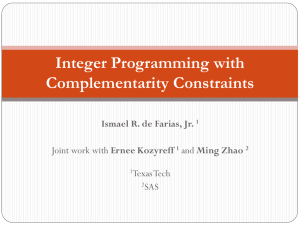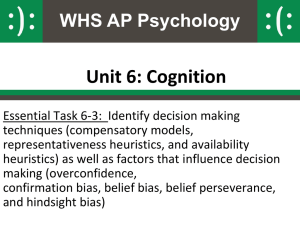A heuristic method for MINLP
advertisement
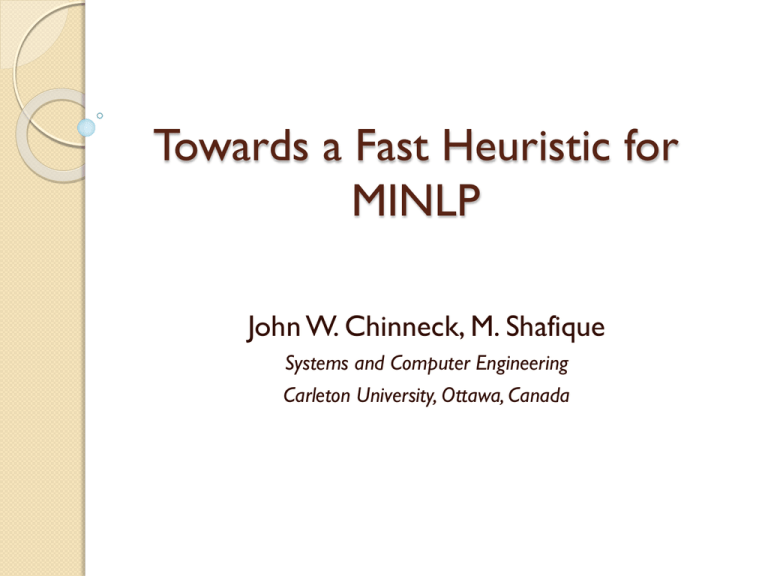
Towards a Fast Heuristic for MINLP John W. Chinneck, M. Shafique Systems and Computer Engineering Carleton University, Ottawa, Canada Introduction Goal: Find a good quality integer-feasible MINLP solution quickly. ◦ Trade off accuracy for speed ◦ No guarantee of finding optimum Target: very large MINLP instances Method: use a fast approximate Global Optimizer within a B&B framework A Fast MINLP Heuristic 2 The Fast Global Optimizer Why is nonconvex GO hard? ◦ Multiple disconnected feasible regions ◦ Multiple local optima ◦ Many places to look for optima Two main categories of methods: ◦ Space-covering global optimizers: Accurate, but slow: inherent tree search ◦ Multi-start local optimizers: Faster, but not as accurate: whole space not searched Goal: fast and reasonably accurate GO ◦ Trade a little accuracy for speed A Fast MINLP Heuristic 3 GO Components Main idea: Multi-start based (for speed) Better exploration of the variable space before launching the local solver (for accuracy) ◦ Our main contribution Main steps: Goal: find local solver launch points that lead to global optima 1. Latin Hypercube sampling in a defined launch box 2. Constraint Consensus concentration 3. Clustering 4. Simple Search 5. Local solver launches A Fast MINLP Heuristic 4 1. LHC Sampling in the Launch Box UB2 LB1 UB1 LB2 Initial launch box based on empirical results: • Most NLP solutions are in this range • Shifted appropriately according to the bounds A Fast MINLP Heuristic 5 2. Constraint Consensus (CC) Projection method: iteratively adjusts point to reduce constraint violation(s). Quickly moves initial point to near-feasible final point. Very fast: no matrix inversion, no line search Reduces local solver time, improves success Current Point Compute Feasibility Vectors Compute Consensus Vector A Fast MINLP Heuristic Update Location 6 Constraint Consensus ***add illustration of CC move CC start point After 1 iteration A Fast MINLP Heuristic 7 3. Clustering of CC end points (CB) Single linkage clustering: pts closer than critical distance assigned to same cluster Critical distance: based on distribution of inter-point distances ◦ Small distances: points in same cluster ◦ Large distances: points in different clusters ◦ Choose critical distance based on this Effect: clusters correlate with feasible regions A Fast MINLP Heuristic 8 LHC Final clusters CC end pts Inter- point distances A Fast MINLP Heuristic 9 4. Simple Search (SS) Derivative-free neighborhood search for better points in a cluster ◦ considers both feasibility and objective function Point quality metric (minimization): ◦ Penalty function: P(x) = f(x) + (maximum violation)2 1. Interior random search 2. Exterior random search x x Replace worst point Continue until no improvement for several iterations A Fast MINLP Heuristic 10 Serial, but parallelizable. 2 - 4 rounds. LHC Serial CC Parallel CB Serial SS Parallel Complete GO Algorithm Select launch pts Serial. Identify x having best P(x) value. Note it’s round. Take best point in each of 3 best clusters in that round. Local solver Parallel Result A Fast MINLP Heuristic 11 Experimental Setup: Software Test set: CUTeR [3] models having at least one non-linear function (constraint or objective) ◦ Small (<300 constraints): 751 models ◦ Medium (300-999 constraints): 29 models ◦ Large (1000+ constraints): 99 models Software: OS: Fedora 17, 64 bit. Compiler: GCC 4.7.2 Local solver: IPOPT 3.11.1, linear solver MA86 serial mode, default settings Parameter settings: ◦ ◦ ◦ ◦ ◦ Time limit: 500 seconds Feasibility tolerance: 1×10-6 throughout LHC parameters: 40 points, launch box edge length 2×104 CC parameters: 100 iterations per CC run, time limit: 1 sec/run SS parameters: At least 10 points per cluster, continue improving until three successive failures. ◦ 2 rounds A Fast MINLP Heuristic 12 Experiment 1: Hardware For BARON, Couenne, SCIP, LINDO: ◦ 2.66 Ghz 64-bit Intel Xeon X5650 ◦ All results from Nick Sahinidis, March 2013 For our method: ◦ 3.4 GHz 64-bit Intel i7-2600, 16 GB RAM ◦ 4 cores, so 4 simultaneous threads But 3 parallel local solver launches (3 points kept) Times adjusted by CPU benchmarks A Fast MINLP Heuristic 13 Small Models • • Log scale solution quality Linear scale solution time • Scaled by CPU benchmarks Medium Models Large Models Success Rate Problem Category Solver Returns a Solution for % of Models CCGO BARON COUENNE LINDO SCIP Small 91.48 90.55 71.90 84.02 78.56 Medium 86.21 93.10 82.76 82.76 86.21 Large 85.86 88.89 66.67 21.21 66.67 Experiment 2 All solvers on same hardware: ◦ 3.4 GHz 64-bit Intel i7-2600, 16 GB RAM ◦ 4 cores, so 4 simultaneous threads But 3 parallel local solver launches (3 points kept) Best feasible or optimal soln within 500 sec Vs. AMPL-linked free solvers: ◦ SCIP 3.1.0 ◦ Couenne 0.3.2 ◦ Waiting for AMPL-BARON A Fast MINLP Heuristic 18 Small Models A Fast MINLP Heuristic 19 Medium Models A Fast MINLP Heuristic 20 Large Models A Fast MINLP Heuristic 21 Small Models Medium Models Large Models A Fast MINLP Heuristic 22 Towards MINLP Goal: few local solver launches Main ideas: Solve GO problem approximately ◦ LHC-CC-CB-SS, but no local solver launch B&B on integer variables at approximate GO solution When all integer variables fixed at integer values, launch local solver A Fast MINLP Heuristic 23 Start Approx GO soln for all new nodes Integer feasible? Y N Fix integer variables and launch local solver Add node to list (unless pruned) Update incumbent? Node list empty? Remove node from list N Y Select node based on P(x) Exit Create child nodes by branching on integer variable A Fast MINLP Heuristic 24 Branching Issues Approximate solution affects branching MILP: ◦ Exact solver ◦ Branching tends to increase integrality MINLP with approximate GO solution: ◦ Branching may not force early integrality ◦ May have to branch until upper bound = lower bound A Fast MINLP Heuristic 25 Branching Issues (contd) Round to integrality within a (larger) tolerance (e.g. 0.1)? Seed the initial random sample of the new subspace with a rounded solution. ◦ Parent solution (11.6, 12.2, 9.5) ◦ Down branch special point (11.6, 12.2, 9.0) ◦ Up branch special point (11.6, 12.2, 10.0) Take action if too many open nodes ◦ E.g. round integer variables and launch local solver to get a better incumbent A Fast MINLP Heuristic 26 Spatial Branching Likely not needed If needed: CC start-end pairs map basins of attraction for feasible regions ◦ Subdivide using CC start-end pairs to define basins of attraction A Fast MINLP Heuristic 27 Conclusions GO results are promising! ◦ Good quality solutions ◦ Solutions usually faster Future MINLP work: ◦ Algorithm optimization Tuning all GO parameters. Better simple search? Best number of parallel threads Where to use them? More threads per node? Solve multiple nodes simultaneously? Parallel rounds? Rounding heuristics ◦ Proper comparison to other MINLP solvers A Fast MINLP Heuristic 28 Looking for Postdoc or PhD Student MINLP and other optimization topics Algorithm development and testing Good programming skills Helpful to know: ◦ Parallel programming ◦ C, C++, Go, Julia Should like winter A Fast MINLP Heuristic 29 References 1. J.W. Chinneck (2004)."The Constraint Consensus Method for Finding Approximately Feasible Points in Nonlinear Programs", INFORMS Journal on Computing16,(3)255-265. 2. W. Ibrahim, J.W. Chinneck (2008). Improving Solver Success in Reaching Feasibility for Sets of Nonlinear Constraints, Computers and Operations Research 35(5)1394-1411. 3. L. Smith, J.W. Chinneck, V. Aitken (2013). “Constraint Consensus Concentration for Identifying Disjoint Feasible Regions in Nonlinear Programs”, Optimization Methods and Software 28(2)339–363. 4. http://www.cuter.rl.ac.uk/Problems/mastsif.shtml 5. A. Waechter, L.T. Biegler (2006).“On the Implementation of a PrimalDual Interior Point Filter Line Search Algorithm for Large-Scale Nonlinear Programming”, Mathematical Programming 106:25-57. A Fast MINLP Heuristic 30
